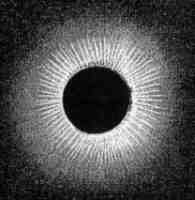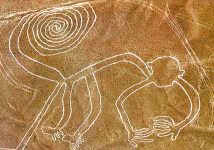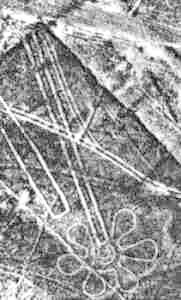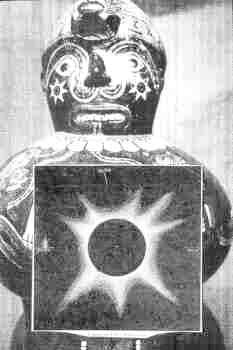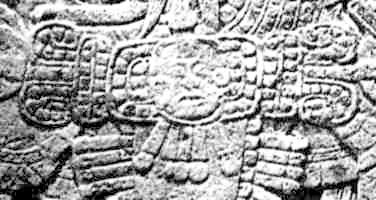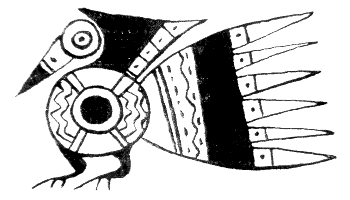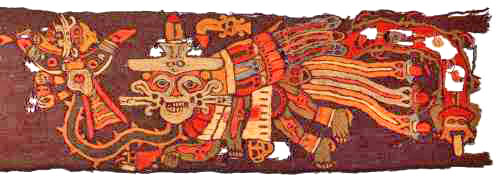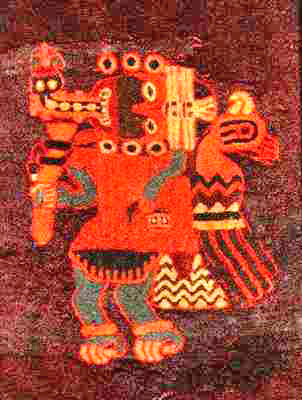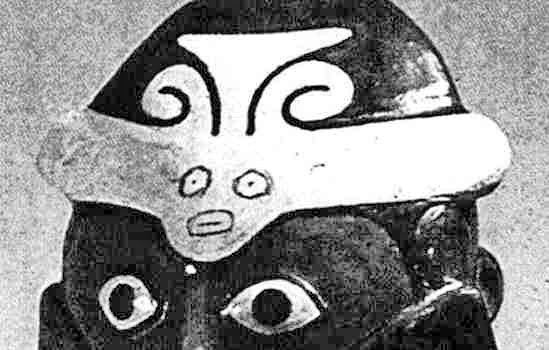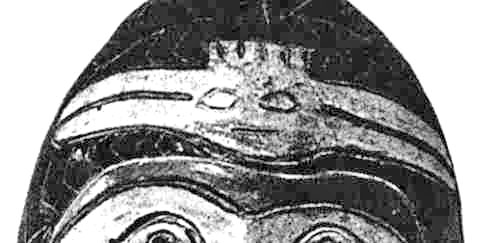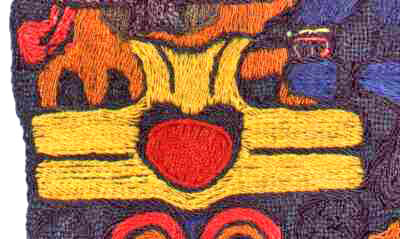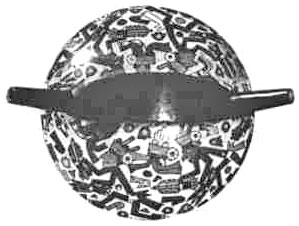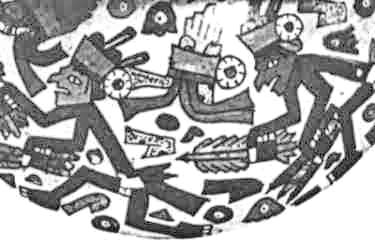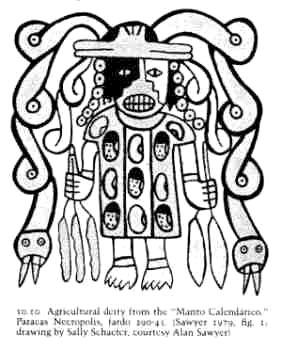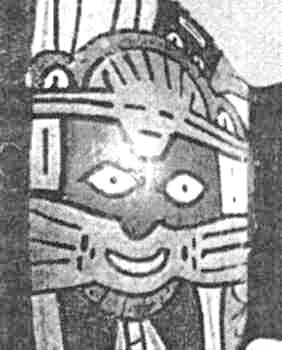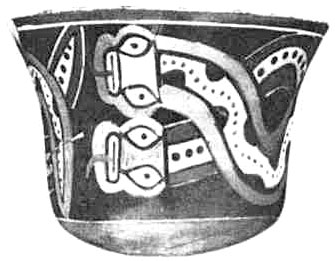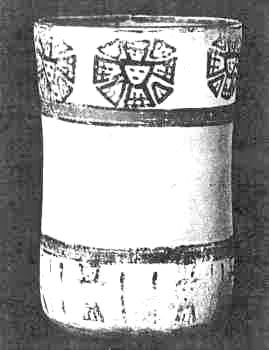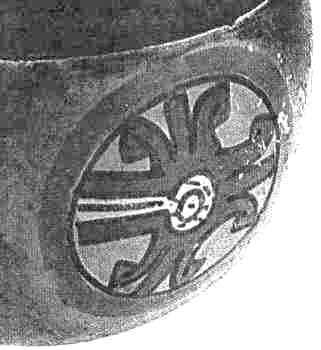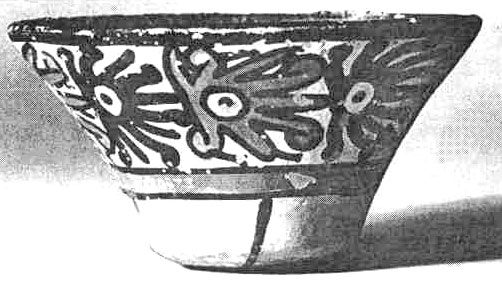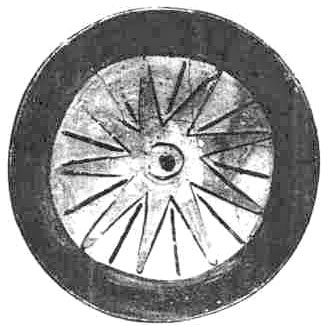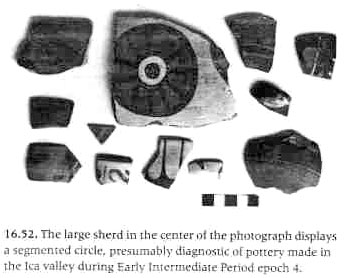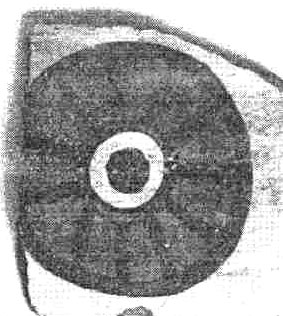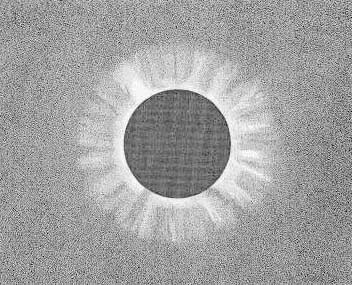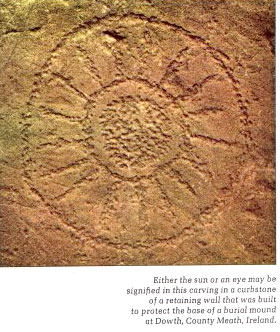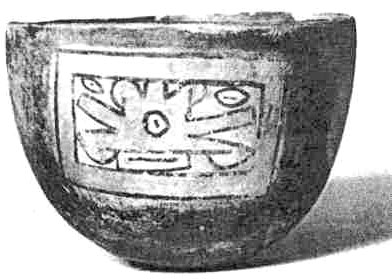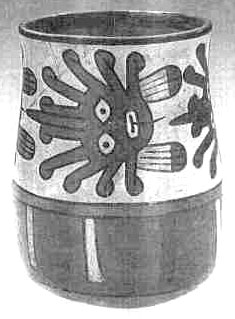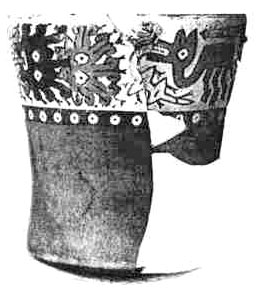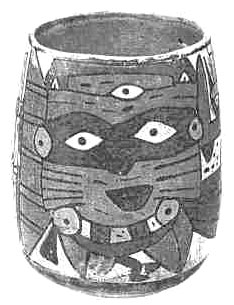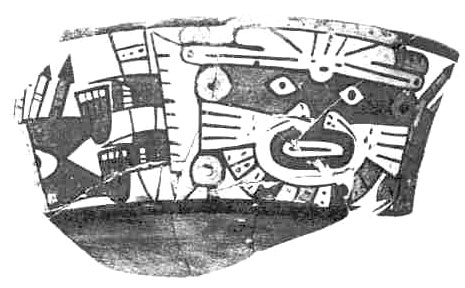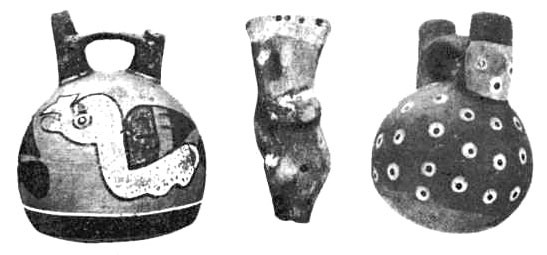|
Nazca Geoglyphs and the Eclipse - "Eye in the Sky" that Inspired Them
The ancient Nazca culture of southern Peru is probably most renowned for the mysterious lines and geoglyphs that it inscribed on the high desert plain in the region of Nazca, beginning over two millennia ago. These imposing lines, which extend for hundreds of meters, and monumental images of birds, spiders, monkeys, fish, flowers or rosettes and other natural forms are best seen by eyes that are high above them in the sky.
It is in fact very difficult, indeed in most cases quite impossible, to properly view these extensive lines and prodigious geoglyphs from ground level. Modern archaeologists only rediscovered these ancient geoglyphs after commercial pilots who had flown over them in the late 1930’s reported their existence.
These theories range from the comparatively conservative theories of modern archaeologists to Erik von Daniken’s original, but highly controversial, proposal that the lines of Nazca were landing strips for ancient visitors from outer space while the geoglyphs served as signals to these space alien ‘gods’. Ironically, but perhaps not surprisingly, it is this latter ‘hypothesis’ that was in fact quite instrumental in bringing the existence of the mysterious Nazca Lines to widespread public attention.
The Nazca Lines, and more particularly the wonderful animal geoglyphs, are certainly ancient religious art. The geoglyphs served not only as an impressive offering of art honouring these sky dwelling gods but very possibly were even intended to be ‘signals’ to these sky gods in an effort to communicate with them.
A sampling of Nazca
geoglyphs While Erik von Daniken was, in my view, not out of line in suggesting that the various geoglyphs served as signals to the gods of the ancient Nazcas it is quite unnecessary for these sky gods to be prehistoric visitors from outer space. Indeed there is no solid evidence to support his thesis that the Nazca Lines were landing strips for their space vehicles and plenty of evidence that serves to thoroughly invalidate this proposal.
A radiant “All Seeing Eye of God” that was clearly solar in nature (albeit frequently depicted within a triangle) was a popular symbol of God’s omniscience in the 18th century. This symbol hovers over the altars of Baroque churches and appears on coins of the period. A version of this symbol, which was adopted by Freemasons, is incorporated into the Great Seal of the United States of America. It is still printed on the reverse side of every single U.S. one dollar bill. Even today there are various cultural and religious traditions that preserve the ancient belief that the sun actually is, or, perhaps more realistically, symbolically represents, the “All Seeing Eye” of God.
I have very good reason to believe that the lines and geoglyphs drawn by the ancient Peruvians on the Nazca plateau were created primarily for the viewing pleasure of our resplendent sun and serene moon. I have even better reason to believe that the creation of the Nazca Lines was directly inspired by the genuinely remarkable series of solar eclipses that occurred over southern Peru during the time period over which the Nazca Lines were created.
Artists depictions of
a total solar eclipse and the human eye I am convinced that the Nazca Lines were meant to be seen by the sun and moon who were considered to be gods throughout the ancient world. More particularly, however, I have every reason to believe that the Nazca geoglyphs were directly inspired by and were also intended to be viewed by a third, and supremely important, sky god of the ancient Americas. I am referring of course to the celestial jaguar god that was believed by numerous pre-Columbian cultures to devour the sun and moon during their respective eclipses.
I have no doubt that the ancient Nazcas at some point perceived the “Eye in the Sky” (or what modern eclipse observers metaphorically refer to as the “Eye of God”) that briefly gazes down upon the Earth from the darkened heavens during what is certainly the most awe inspiring of regularly occurring celestial phenomenon known to man, the total eclipse of the sun. It is possibly an attempt to placate and propitiate this truly magnificent, yet doubtlessly terrifying, ‘radiant divine eye’ that caused the ancient Nazcas to create the monumental works of religious art that have graced the pampas of Southern Peru for many centuries.
These eclipse charts clearly show that several remarkable series of total and annular solar eclipses occurred in close succession over southern Peru beginning with a period that somewhat predates with the construction of the earliest known Nazca lines and geoglyphs. This amazingly high incidence of solar eclipses lasted throughout the duration of time over which the Nazca Lines were created. The extraordinarily high incidence of solar eclipses charted on these maps in the region of southern Peru during the period in which the Nazca culture flourished should serve to validate my thesis that the Nazca lines were made in direct response to the remarkable “eye in the sky” that is clearly perceivable during a total solar eclipse.
The diameter of the penumbra is about 150 miles and the shadow traced on the surface of the Earth during totality extends for at least several hundred miles. Typically it is a couple of thousand miles long. The area within which human eyes may witness a total solar eclipse and perceive the proverbial ‘eye in the sky’ is thus quite large. “On average” it would be about two or three hundred thousand square miles in area.
Oppolzer’s Canon charts major solar eclipses occurring over the region of the Nazca lines in 151 BCE and 122 BCE. These eclipses were followed by a series of three major eclipses of the sun within a fifteen year period beginning in 97 BCE and thus coinciding with the construction of the earliest lines and geoglyphs drawn on the Nazca plateau.
An Annular Eclipse of
the sun occurred in 97 BCE. The solar eclipse of March, 97 BCE was either a total eclipse or a, very nearly total, annular eclipse. It was followed less than four years later by a total solar eclipse occurring in December of 93 BCE and yet another total solar eclipse in May, 82 BCE. I have very good reason to believe that this unusual series of total solar eclipses would have given ample opportunity for the Nazca Indians to observe this unique, spectacular, and awe-inspiring celestial phenomenon.
As a direct result of these observations they eventually become attuned to the fact that the total eclipse of the sun bears a striking and uncanny resemblance to a “radiant divine eye” staring down from the heavens. This awareness then inspired the Nazca Indians to commence the construction of the earliest lines and animal figures in response to the “eye in the sky” that they perceived during these eclipses.
This human figure may be readily
perceived to be indicating that that which is seen in the skies
above is reflected in what is seen on the earth below. This would
tend to support my contention that the Nazca Lines and figures were
constructed in response to the remarkable visual phenomenon of the
‘eye in the sky’ that is manifested during a total solar eclipse.
The “rosette” is a stylized depiction of the sun which incorporates elements that are seen only during a total solar eclipse, namely the many rays and streamers of the sun’s corona. Modern astronomers, including professionals, and other contemporary eclipse observers have repeatedly compared the totally eclipsed sun to a flower. The “petal-like” form of the coronal streamers was perceived by Victorian eclipse observers and has been reproduced in19th century scientific astronomical drawings of the corona. A rational comparison of 19th century drawings of total solar eclipses with various examples of the ubiquitous “rosette” symbol will quickly convince most reasonable, open-minded, people of the solar origin of the “rosette.”
This Nazca Lines
“rosette” symbol was probably inspired by the flower-like appearance
of the totally eclipsed sun Annular eclipses occurred in southern Peru in 53 BCE, 27 AD, and 56 AD. This was followed by a full century without any solar eclipses until a total eclipse occurred somewhat to the north of the Nazca lines in 157 AD. An annular eclipse followed shortly thereafter in 160 AD and then two total eclipses took place within a year and a half, the first in June of 178 AD the second in November of 179 AD. The fact that these two total solar eclipses occurred in such rapid succession may have prompted a resurgence of line and animal figure ground drawings in the latter half of the 2nd century AD.
A Total Solar Eclipse occurred near the Nazca Lines
soon after sunrise
near the time of the Southern Hemisphere’s winter solstice in 317
AD. While some of the cruder geoglyphs at Nazca were probably created before the birth of Jesus of Nazareth most archaeologists believe that their highest development was between the years 400 and 700 AD.
According to Theodore von Oppolzer’s Canon der Finsternisse less than seven major eclipses of the sun occurred within the greater region around the Nazca Lines in the 5th century AD (i.e. 411, 417, 421, 443,478, 483 & 497 AD); eight solar eclipses occurred in the 6th century AD (i.e. 504,523, 537, 544, 548, 558, 587 & 598 AD); and a truly remarkable thirteen solar eclipses darkened the skies over southern Peru in the 7th century AD (i.e. 609, 613, 617, 642, 645, 646, 652, 661, 667, 668, 688, 692 & 699 AD).
We must not forget that there would quite likely have been some communication with other cultures to the north and south of Nazca. These ancient Peruvian cultures would also have been directly affected by the phenomenon of solar eclipses as is clearly evident from the images appearing on their pottery, textiles, and other artifacts.
A Total Solar Eclipse
occurred near the Nazca Lines in 478 AD.
and a Total Solar
Eclipse occurred to the south of them. Of the seven solar eclipses that occurred in the 5th century four were total and two of these passed directly over the Nazca lines according to von Oppolzer’s charts of solar eclipses. The first occurred on April 18, 478 (Julian calendar date), and it was followed by another on January 24, 483. That is two total eclipses of the sun within less than five years. It could thus be quite reasonably expected to have inspired the Nazca Indians to respond once again to this “eye in the sky” by constructing more of the, hopefully now somewhat less mysterious, lines and geoglyphs that are only clearly visible from high in the the air.
As it turns out, numerous wooden pegs have been found at various points along the Nazca lines. These wooden pegs were clearly used to trace out the Nazca Lines and gigantic figures. In ‘Art of the Incas’ by Henri Stierlin we read,
Knowing this it should then not only be possible, but also a relatively straightforward exercise, to determine which lines and figures were constructed after the two total solar eclipses of 478 and 483 by determining which figures and lines were associated with wooden pegs that date to the latter part of the 4th century AD. Other lines and figures could be correlated to earlier or later solar eclipses by using this method and a complete chronology of the construction of the Nazca Lines could be established from this data. I am assuming that this has not already been done.
It would then be a fairly simple matter to determine which of the Nazca Lines and geoglyphs were constructed following the aforementioned solar eclipses. It is possible that some lines may have been constructed in the periods intervening between solar eclipses if some of the lines were in fact used as a means of calculating when another solar eclipse might occur.
A Total Solar Eclipse occurred near the Nazca Lines a general lack of heavy clouds in the region and thus better than average solar eclipse viewing conditions.
The seven pointed stars distinctly resemble some 19th century astronomical drawings of the total solar eclipse and I do not think that it is in any way insignificant that they appear in close conjunction with the eyes. The serpent is a creature that is associated with the eclipse in many cultures since it represents the cyclical nature of celestial events in its sinuous movement and also because the chromosphere that surrounds the moon during totality resembles a crimson serpent with red rearing heads.
Starry-eyed Nazca
figurine with a drawing of total solar eclipse A Nazca bowl depicts a face which sports under each eye a marking that distinctly resembles the outstretched wings on either side of a bird-like tail. The tail projects from directly below the pupil of the eye, which is represented as a black cube extending from top to bottom of a white ellipsoid. The wings spread out on either side of the tail reaching almost to the outer edge of the ellipsoid eyes. It is possible that these markings are intended to represent tears but even if they do I do not think that their similarity to the Egyptian and Mesopotamian winged disc symbol is purely accidental.
It is equally possible, indeed in my opinion more it is far more likely, that these “wings” represent markings that the Nazca Indians painted on to their faces for decoration. Decoration that was intended to symbolize the “eye in the sky,” the “winged disk,” the total eclipse of the sun.
These “parrots” bear a striking resemblance to some Mesopotamian versions of the “ring with wings” symbol where the ring or sun disc hovers over, or is supported by, the wings rather than enclosed between them. I believe that it is quite likely that these parrot like figures might also have been intended to symbolically represent the total eclipse of the sun.
Compare the Nazca Lines headless bird figure (which appears to contain a human face within the bird’s “body”) to the Assyrian winged sun symbol on the right.
Now compare both of these to the Mayan Sun God pectoral below
left... A picture is indeed worth a thousand words... or more! It should be obvious by now that the headless bird with the human face in its “body” (which up to now has been interpreted as a colibri) is in fact a Nazca culture representation of their Sun God
whose bird-like form was clearly
manifested during some total solar eclipses. Similar birds, whose heads are represented as concentric circles with beaks attached, appear on the textiles, pottery, and other art works of other Peruvian cultures. A very interesting example of Ica fabric depicts parrots with normal size eyes and proper heads flanked on either side by human figures wearing “crowns” bearing eyes and plumes. These plumes are very reminiscent of the polar; bird-tail-like rays of the “winged sun” corona that is characteristic of the sunspot minima phase. In fact many modern astronomers refer to the polar rays as plumes in their scientific literature.
Nazca bird with
distinctly solar eye-spots Another example that appears on pottery from the Lambayeque culture of northern Peru which thrived between 700 to 1200 AD would pretty much confirm that these types of bird figures allude to the total solar eclipse. Not only is the head of this bird composed of concentric circles, its body is a large circle the centre of which is a black pupil-like dot whose diameter is one third of the diameter of the outer circle. This ‘pupil’ is surrounded by a substantial white ring from which projects four bars in the form a letter ‘X.’
Wave-like forms fill the spaces between the bars of the cross on the horizontal or ‘equatorial’ axis to the left and right of the ‘pupil’ while the upper and lower or ‘polar’ spaces are left void. The similarity of the bird’s body to both an eye and the total solar eclipse is immediately obvious. There can be very little doubt that this strange bird is a solar eclipse symbol. The use of the X-like cross containing a wave-like pattern between its arms only serves to underline this proposition.
Lambayeque culture
sun-bird figure On another example of Nazca pottery bizarre winged cyclopean beings encircle the bottom and top of a flared bowl, on either side of what appears to be a serpent. A rayed triangle graces the top of an ellipsoid eye and a grinning mouth encircles the bottom of the eye. Wings extend from either side of the triangle-eye-mouth part of these beings and what appears to be a tongue forms their lower body, although it does not project from between the lips of the mouth but rather extends from below the lower lip. Flame-like projections extend from the lower part of the tongue where one would normally expect the legs of a bird to be depicted if the drawing was a representation of a bird.
A bird-like tail projects downward from the tip of the tongue to complete these winged “Cyclops” figures. It is immediately clear that these figures do not represent any known form of bird but that rather they depict a mythical being. These figures bear a close resemblance to a Peruvian mythical being that modern anthropologists have dubbed, “The Oculate Being,” more simply, “The Eyed Being.”
The tongue would then be phallic of course and associated with the sun which was a male symbol to the Incas and most probably to the surrounding Peruvian cultures. The sexual union or “marriage” of sun and moon would thus be clearly implied in this interpretation of the symbolism of these “Cyclopean,” winged, “Oculate Beings” and would further tend to link them with the total eclipse of the sun.
Even the mouths of these figures resemble eyes since they are depicted as being white horizontal ovals with an inner black horizontal slit in stark contrast with the dark skin colour of their faces. Clearly the eye was of paramount symbolic importance to the Nazca Indians and just as clearly it was a symbol that was closely associated with sexual reproduction, fertility, and birth.
Nazca figures with
gazing navels! I am not the first person to postulate that some of the animal figures depicted on Nazca pottery were mythical beings that were inspired by the celestial phenomenon of the total eclipse of the sun. Gerald S. Hawkins, who was one of the very first astronomers to give serious credence to the theory that Stonehenge and other megalithic sites were astronomical calendars. He later studied the Nazca Lines to try to determine whether or not they had significant astronomical alignments.
I believe that Gerald Hawkins totally correct in his identification of the jaguar-god that is frequently depicted on Nazca pottery and textiles with the sun and moon devouring sky-god of South America. I might add that one of the primary reasons that the jaguar would be identified with the all-powerful sun god all around the globe is the pattern of eye-like spots on its fur. These eyespots are known in biological terminology as “oculli,” a word that traces its roots to the Latin word for eye.
This would again tend to confirm my contention that the Nazca Indians were perfectly aware of the eye-like appearance of the total solar eclipse and that the impressive lines and beautiful geoglyphs that they constructed were a direct response to this remarkable phenomenon. The fact that the Nazca version of the jaguar eclipse god almost invariably wears a head ornament or crown that resembles a white bird similar to the “Sun-Bird” that is clearly perceivable in the sun’s corona underlines the fact that the total solar eclipse had a profound impact on Nazca religious beliefs and religious iconography.
Nazca version of the
jaguar eclipse-god I believe that I have now presented sufficient evidence to convince all but the most skeptical reader that the Nazca Lines were almost certainly inspired by the genuinely remarkable visual phenomena that are readily perceivable during total solar eclipses.
This Sun Bird is represented on their pottery, textiles and, as far as I am concerned, at least one of the bird geoglyphs at Nazca. I believe that my theory is one of the most rational explanations of the mystery as to why the Nazca Lines were created. I am confidant that further research of the Nazca culture, as well as the lines and geoglyphs that the Nazcas created, will generally tend to validate my theory rather than discredit it.
Nazca sun-bird
headdress
that is clearly
perceivable looking down from the sky during total solar eclipses.
to the scientific astronomical drawing of a total solar eclipse and the Dowth petroglyph below.
was most probably
inspired by solar prominences visible during total solar eclipses.
|


